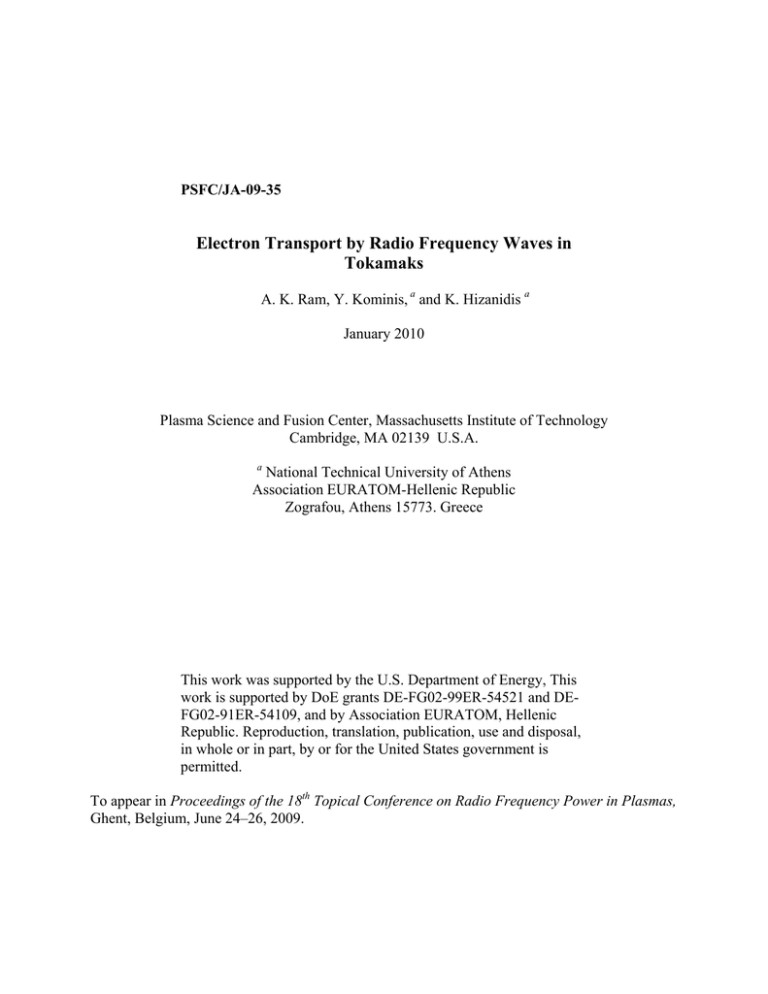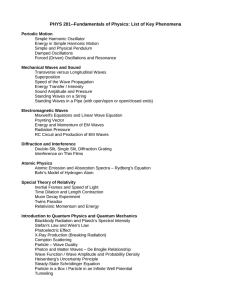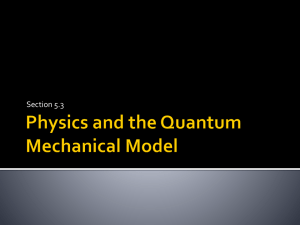Electron Transport by Radio Frequency Waves in Tokamaks
advertisement

PSFC/JA-09-35
Electron Transport by Radio Frequency Waves in
Tokamaks
A. K. Ram, Y. Kominis, a and K. Hizanidis a
January 2010
Plasma Science and Fusion Center, Massachusetts Institute of Technology
Cambridge, MA 02139 U.S.A.
a
National Technical University of Athens
Association EURATOM-Hellenic Republic
Zografou, Athens 15773. Greece
This work was supported by the U.S. Department of Energy, This
work is supported by DoE grants DE-FG02-99ER-54521 and DEFG02-91ER-54109, and by Association EURATOM, Hellenic
Republic. Reproduction, translation, publication, use and disposal,
in whole or in part, by or for the United States government is
permitted.
To appear in Proceedings of the 18th Topical Conference on Radio Frequency Power in Plasmas,
Ghent, Belgium, June 24–26, 2009.
Electron Transport by Radio Frequency Waves
in Tokamak Plasmas
A. K. Ram∗ , Y. Kominis† and K. Hizanidis†
∗
Plasma Science and Fusion Center, Massachusetts Institute of Technology, Cambridge,MA 02139.
USA
†
National Technical University of Athens, Association EURATOM-Hellenic Republic,Zografou,
Athens 15773. Greece
Abstract. A relativistic kinetic description for momentum and spatial diffusion of electrons by
radio frequency (RF) waves and non-axisymmetric magnetic field perturbations in a tokamak is
formulated. The Lie perturbation technique is used to obtain a non-singular, time dependent evolution equation for resonant and non-resonant electron diffusion in momentum space and diffusion
in configuration space. The kinetic equation for the electron distribution function is different from
the usual quasilinear equations as it includes interactions that are non-Markovian. It is suitable for
studying wave-particle interaction in present tokamaks and in ITER. A primary goal of RF waves,
and, in particular, of electron cyclotron waves, in ITER is to control instabilities like the neoclassical
tearing mode (NTM). Non-axisymmetric effects due to NTMs are included in the kinetic formalism.
Keywords: Kinetic theory, wave-particle interactions.
PACS: 52.50.Sw, 52.50.Qt, 52.40.Db
INTRODUCTION
The interaction of electrons with RF waves in tokamaks encompasses interesting and
complex physics. The externally launched RF fields are localized, in space, and do not
uniformly fill the toroidal plasma. So the dynamical phase space of the electrons, in
general, is a composite of chaotic motion, motion in and around islands, and regular
motion. Taking all of these aspects into account, we have derived the relativistic operator
for momentum and spatial diffusion of electrons by RF waves and due to NTMs in a
tokamak [1]. The operator is suitable for numerical implementation. It is not plagued by
the resonant delta function which appears in previous formalisms [2, 3] and gets treated
in an ad hoc fashion in numerical codes. The momentum diffusion leads to plasma
current and the spatial diffusion affects the radial current profile.
DIFFUSION AND FOKKER-PLANCK DESCRIPTION
The evolution of the electron distribution function in the presence of RF waves is given
by Fick’s second law or the Fokker-Planck equation
½
¾
∂ f (I)
∂
∂
=
D(I) f (I)
(1)
∂t
∂I
∂I
where I is a vector of the dynamical actions (or variables describing the electron dynamics), f is the distribution function, and D is the diffusion tensor. D contains all the
necessary information about the interaction of electrons with waves. The time step that
appears on the left hand side of (1) and the form of D(I) are inputs that have to be determined independently. For this it is instructive to consider the standard map [4] which
describes, in one-dimensional space, the interaction of a charged particle with an infinite set of plane electrostatic waves. The waves have the same wave number but their
frequencies are integer multiples of a fundamental frequency.
dx
= v,
dt
dv qE ∞
=
∑ sin (kx − nω t)
dt
m n=−∞
(2)
Here x and v are the position and velocity of a particle of charge q and mass m,
respectively, k and ω are the wave vector and angular frequency, respectively, and E
is electric field amplitude of each wave. The change in particle velocity and wave phase
after every time step T = 2π /ω is given by
In+1
θn+1
=
=
In + K sin θn (mod 2π )
θn + In+1
(mod 2π )
(3)
(4)
where θ = kx, I = kT v and K = (2π /ω )2 (qkE/m) is the normalized amplitude.
It is well known that as K increases the dynamical phase space becomes chaotic [4]
and diffusion of the electrons in action space I ensues. If we make the Markovian
assumption (Brownian motion) that the particle motion randomizes in a single step
I0 → I1 , then we obtain the quasilinear diffusion
D
E
Z
(I1 − I0 )2
1 2π
K2
=
(5)
DQL ≡ D1 =
d θ0 (I1 − I0 )2 =
2
4π 0
4
where < .. > denotes an ensemble average. An important advantage of the Markovian
assumption is that the long time diffusion (n → ∞) is the same as for a single step. Thus,
the time step on the left hand side of (1) corresponds to a single interaction time. On the
right hand side of (1), D = DQL is independent of I. This is a property of the standard
map for which the entire phase space is affected as K increases.
It turns out that the Markovian assumption is not valid for the standard map. As
Rechester and White pointed out in [5], the diffusion coefficient is markedly different
from DQL . Only for very large, and impractical, K does the actual diffusion approach
DQL . In [5] the diffusion is defined by
D
E
2
(In − I0 )
D ≡ Dn =
(6)
2n
for n À 1. The particle motion is not de-correlated in one interaction time but takes
significantly larger number of interactions. Then the evolution time step on the left hand
side of (1) has to be large enough for decorrelation of the particle orbit in its interaction
with electrostatic waves. The correlation function
D³
´³
´E
(p)
(p)
(p)
(p)
Cn = In − In−1 I1 − I0
p
(7)
where < .. > p is an ensemble average for a set of randomly distributed particles. The
correlation time nc is such that for n > nc we have Cn ≈ 0.
While the standard map is quite idealistic in terms of representing wave particle
interactions it exhibits interesting physical properties which can be well analyzed. One
idealization is that the entire particle phase space is affected. This is not the case
when RF waves are used to heat or drive currents in laboratory plasmas. The waves
are localized in space and only part of the particle distribution function is affected
by the waves. Some aspects of particle interaction with spatially localized fields has
been studied in [6]. There are several points that become evident from this study: the
diffusion defined by (6) is dependent on the number of interactions n and the initial
energy (or velocity) of the particles I0 . The primary reason for these dependencies is that
the affected particle phase space is bounded. In the limit n → ∞ it is evident from (6) that
Dn → 0. For the standard map this is not the case. Also, particles near the boundaries
of the RF affected phase space behave differently from those away from the boundaries.
Thus, for a proper description of the interaction of electrons with RF waves in tokamaks,
we need a different approach.
KINETIC FORMULATION OF RF INDUCED TRANSPORT
We make use of the Hamiltonian formalism and the Lie perturbation method to derive a
kinetic equation for the evolution of the electron distribution function in the presence of
RF waves in a tokamak. Since the RF waves can be poloidally and toroidally localized,
an electron interacting with RF waves during one toroidal transit may not do so during its
next transit. The drifts induced by toroidal and poloidal magnetic fields and the magnetic
trapping of electrons are properly taken into account in our formalism. The effect of
magnetic field perturbations, e.g., due to NTMs, are also included in the dynamics of
electrons.
The dynamics of electrons in a tokamak and their interaction with RF waves is given
by the Hamiltonian
H (J, θ ,t) = H0 (J) + ε H1 (J, θ ,t)
(8)
where H0 (J) is the unperturbed Hamiltonian that describes the electron motion in an
axisymmetric tokamak. J are the constant actions – the magnetic moment, the toroidal
flux, and the canonical angular momentum. The corresponding canonical angles θ are
the gyrophase of the particle, poloidal angle, and the toroidal angle. The effect of the RF
waves is assumed to be perturbative and given by H1 . In (8) ε is assumed to be less than
one and is an ordering parameter. We carry out a Lie transform canonical perturbation
theory using ε as the expansion parameter. There exists a Lie operator OL such that it
evolves, using the dynamical equations, phase space variables (J, θ ) from their given
values at time t to those at time t + ∆t [1]
OL : (J, θ )t −→ (J, θ )t+∆t
(9)
A distinct advantage of the Lie operator is the way it transforms any function of the
canonical variables
OL −1 f (J, θ ) = f (OL {J, θ })
(10)
If f (J, θ ) is assumed to be the distribution then, from (10),
¡
¢
f (J, θ )t+∆t − f (J, θ )t = OL −1 − I · f (J, θ )t
where I is the identity operator. Dividing by ∆t and taking the limit ∆t → 0 gives
·
¸
¢
∂
∂ ¡
−1
f (J, θ ,t) =
OL − I · f (J, θ ,t)
∂t
∂t
(11)
(12)
which is the evolution equation for the distribution function. The Lie operator OL is time
dependent and contains the dynamics of the entire electron population and its interaction
with RF waves. Equation (12) is completely reversible in time. By averaging over the
angles θ we destroy this reversibility and obtain the diffusion equation
·
¸
∂
∂
∂
f (J,t) =
· D (J,t) ·
f (J,t)
(13)
∂t
∂J
∂J
The diffusion operator D (J,t) is not only a function of the actions but also of time. In
(13) the evolution of f occurs on the same time scale as the evolution of D through
the dynamical equations. The operator D is non-singular. In prior studies on quasilinear
theory [2, 3], the diffusion operator contains a singular Dirac δ function. The singularity
does not lend itself to any sensible numerical implementation.
We refer the reader to [1] for the derivation leading to (13). A more detailed description of the basic evolution equation will be included in an upcoming paper.
ACKNOWLEDGMENTS
This work is supported by by DoE grants DE-FG02-99ER-54521 and DE-FG02-91ER54109, and by Association EURATOM, Hellenic Republic.
REFERENCES
Y. Kominis, A.K. Ram, and K. Hizanidis, Phys. Plasmas 15, 122501 (2008).
C. F. Kennel and F. Engelmann, Phys. Fluids 9, 2377 (1966).
A. N. Kaufmann, Phys. Fluids 15, 1063 (1972).
A. J. Lichtenberg, M. A. Lieberman, Regular and Chaotic Dynamics, second edition (Springer, New
York).
5. A. B. Rechester and R. B. White, Phys. Rev. Lett. 44, 1586 (1980).
6. A. K. Ram, A. Bers, and K. Kupfer, Phys. Lett. A 138, 288 (1989).
1.
2.
3.
4.




